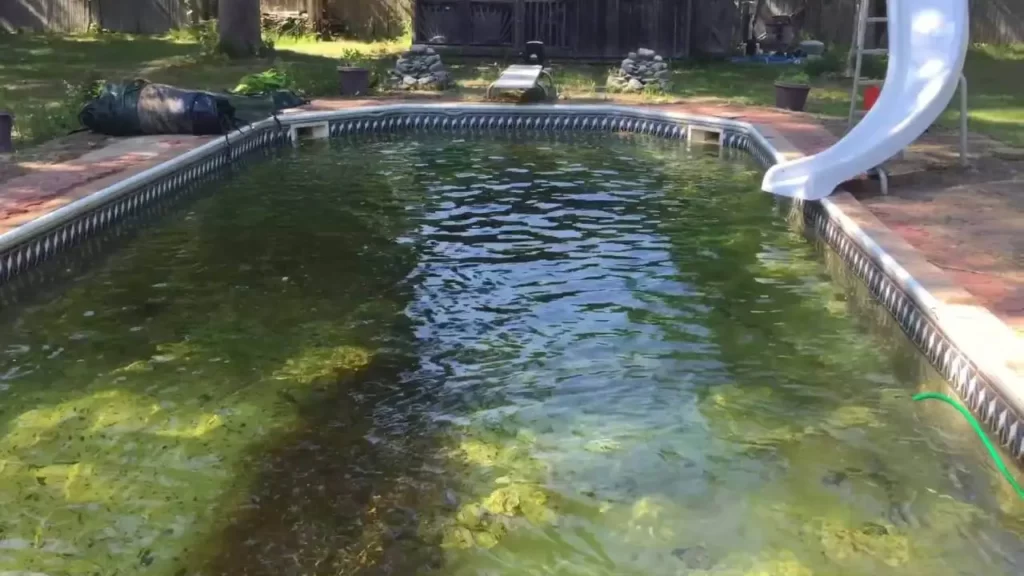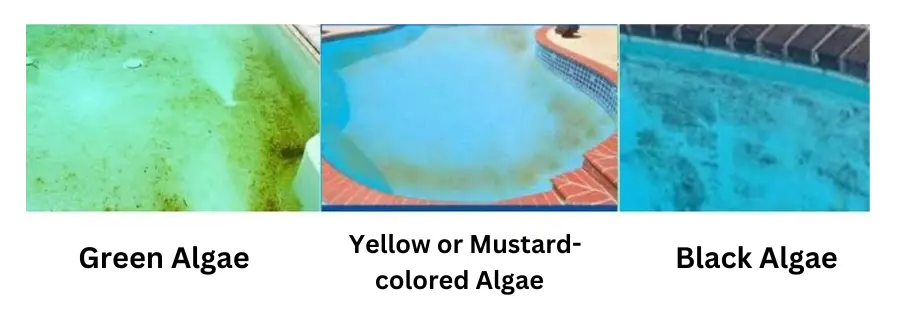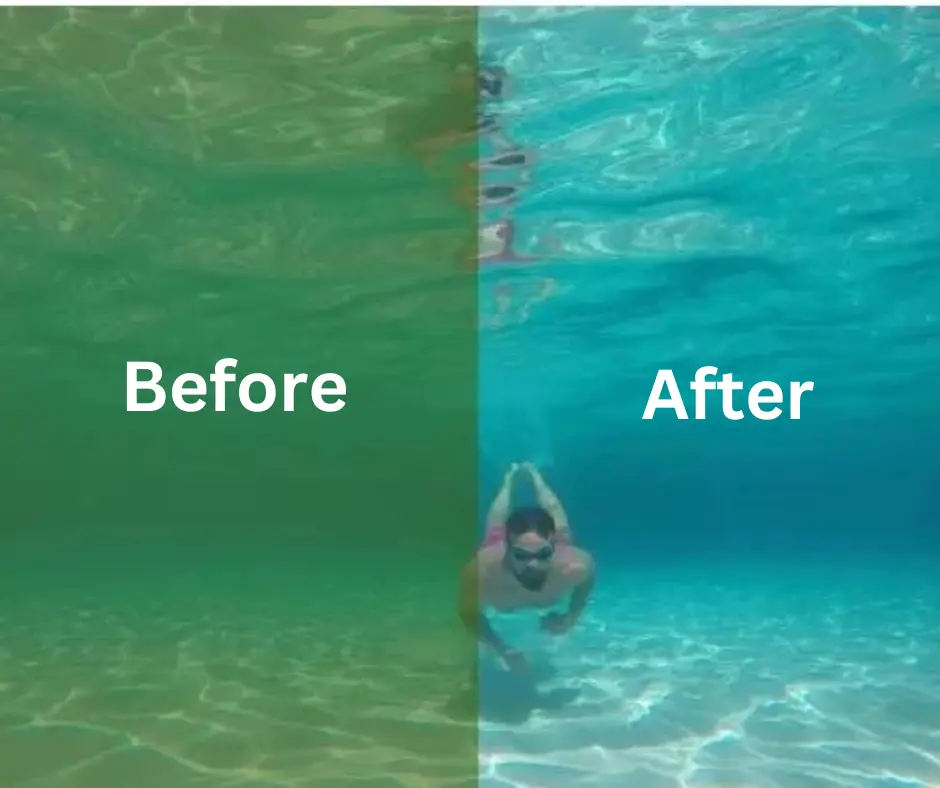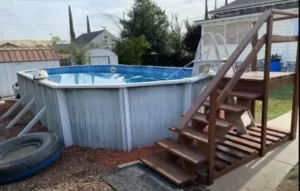In this article we will going to guide you “How to remove algae from pool?” Every pool owner has had problems with algae. Sometimes, despite your best efforts using good pool chemicals, frequent measurements, and maintaining proper chlorine and pH levels, algae suddenly blooms literally before your eyes.
Rectifying the situation requires time, effort and many chemicals – mainly shock chlorine and anti-algae preparations. The plan for a fantastic weekend in the water turns into hard work cleaning the pool. The pool cover helps a lot in preventing algae blooms, but you also need to know where and why the algae problem comes from and How to remove algae from pool.
let’s start ..

Image – How to remove algae from pool?
Contents
What causes algae problems?
Algae spreads whenever the biological environment in the pool changes. Perhaps the sand filter needs backwashing, perhaps rain has reduced the level of free chlorine in the water, or fluctuations in the pH parameter have reduced the effectiveness of the chlorine dosed into the water. Whatever the cause, ultimately you need to deal with algae blooms, and the best way to start the fight is to know your enemy.
Algae spores are always present in and around the pool, and are constantly introduced into the water in many ways – whether through swimsuits, toys, brushes, vacuum cleaners, or simply through wind and rain. In biological conditions ideal for blooming, i.e. when the chlorine level drops below 0.2 ppm and the pH increases at the same time, or when the pump and filter do not work properly, algae may appear within just a few hours.
Algae need only two things to grow: food (sulphates and nitrates) and sunlight (for photosynthesis). In pools with a higher than minimum bathing load, or with higher than average levels of pollution, algae have a real feast. Typically, algae are kept in check by active pool disinfectants (chlorine, oxygen, etc.), but
if they manage to build a permanent foothold in some corner of the pool, the effect of pool chemicals can quickly be suppressed by a bloom. The fight against algae is made much easier by using a pool cover.
When do algae appear?
Favourable conditions in the tank can cause a strong algae bloom. Their accelerated development is influenced by:
- excess DOC – dissolved organic carbon,
- presence of organic compounds in water,
- excess sunlight,
- excess micro and macro elements,
- lack of systematic tank maintenance,
- poor or insufficient, as well as irregular filtration.
Types of Algaes
There are thousands of biologically known Types of algae, but they can be broadly divided by color:

Green Algae is the most common form of algae and also the easiest to destroy. They give the water a greenish color. Often found floating freely in water, although they can also cling to walls. Green algae is the easiest to get rid of, and can usually be successfully controlled with small amounts of additional chlorine and an anti-algae agent.
Yellow or mustard-colored Algae may appear as dust or sand in the corners of the pool. They tend to stick to walls, and can be difficult to completely eliminate because they are resistant to even normal levels of chlorine. Getting rid of mustard algae usually requires a bit more work, e.g. shock chlorination and at the same time mechanical brushing of the walls and bottom of the pool.
Black Algae can be extremely difficult to completely eradicate. They have strong roots that even attach themselves to concrete surfaces and take root in cracks and crevices. If these roots are not completely destroyed, the black algae will grow back. They also have a “shield”, which is a biological protective layer, particularly resistant to pool chemicals. Removing black algae can be a long and difficult process, in extreme cases it requires completely drying the pool and washing its surface with an acidic cleaning agent and a strong jet of water
Read Also – How to clean the bottom of a pool without a vacuum cleaner?
How to remove algae from pool? step by step guides
As we have said, Removing of algae is very difficult. Indeed, its fine powder texture and its high volatility do not allow it to be eliminated in the traditional way with a robot vacuum cleaner and traditional anti-algae treatment products are ineffective.
However, we must not give up. There are solutions to removing Algae from pool.
let’s start the process of How to remove algae from pool? Here are the steps to follow to do this.
Measurements
Before you start eliminating algae, you will need to measure the pH level of your swimming water and its stabilizer level . The pH level should be between 7 and 7.4. Indeed, a pH that is too high will not allow effective cleaning. Likewise, if the stabilizer displays a level greater than 50 ppm, the action of chlorine will be blocked. Be sure to rebalance the dosages before starting. If there is excess, drain part of the pool and repeat the tests
Disinfection of accessories
algae is present in the water, but this germ brought by the winds and rains spreads throughout the environment of the basin. To eliminate it, you must clean and disinfect all pool accessories as well as toys with chlorine or diluted bleach. Swimwear should also be machine washed if it has come into contact with water.
Brushing the walls
With an anti-algae brush, brush the walls of the pool and the bottom. Don’t forget corners and crannies, but also skimmers, spotlights and other elements of the pool, including your shelter, cover, etc. This action will allow you to better remove the algae from the walls in order to vacuum them more easily afterwards.
Vacuum
Vacuum up as much algae as possible with your manual vacuum cleaner in evacuation mode. Once this step is done, adjust the pool water level.
Measurements, again!
Before embarking on the shock treatment of the pelvis, repeat your measurements. It is important that the water balance is optimal to hope for a certain effectiveness. Control the pH level and alkalinity (TAC) of the pool to maximize the effect of chlorine.
Use Algaecide
It is preferable to opt for a Stop Algae product specially formulated to fight against Algae. Algaecide consists of bromide salt made active under the effect of oxidation. It must therefore be coupled with a disinfectant to produce its effect (chlorine, bromine or active oxygen)
Shock treatment
algae is very difficult to eliminate. Consequently, it is recommended to carry out a shock treatment of the water , with chlorine, bromine or with active oxygen. For optimal disinfection, immerse all your equipment in order to clean it thoroughly at the same time.
Filtration
Turn on your filtration system and let it run for at least 8 hours without interruption.
A New shock treatment
A new shock treatment is often necessary to eliminate algae, because they resist chlorine well. Wait 24 hours before considering swimming.
New filtration
Restart the pool filtration again for a continuous period of at least 8 hours .
The last measurements
It is necessary to measure your water again to check the pH and TAC levels. The balance of the water must be optimal. If the water remains a little cloudy, use a flocculating sock to help it become clear again.

How to remove algae from pool? – Results
In this post we guided you and give you all the solution of ” How to remove algae from pool? “
Now lets talk abouts these other necessary things also :
How to protect your pool from Algae?
Even the most effective treatment cannot prevent the return of algae. They are very difficult to eliminate and their diffusion in the wider environment of the basin favours new developments. In regions particularly exposed to risk, particularly windy and rainy regions, it is preferable to act preventively with preventive treatments carried out at least twice during the swimming season.
To keep algae away from your pool, be sure to maintain a good water balance. Monitor pH levels, TAC and disinfectant very frequently to maintain optimal bathing balance.
Also be sure to disinfect your swimming pool equipment regularly. Indeed, wind and rain can deposit algae spores almost everywhere around the pool. This precaution will allow you to limit repeated invasions.
conclusion
Finally, it goes without saying that it is important to properly maintain your swimming pool . The filtration system should operate at least 8 to 12 hours per day, every day! It is also imperative to regularly pass the brush broom on the walls and the bottom as well as the vacuum cleaner.
FAQ
What is the best way to remove green algae from my pool?
Shocking the pool with a high dose of chlorine, brushing the affected areas, and using an algaecide are effective methods for removing green algae.
How do I get rid of yellow (mustard) algae in my pool?
Mustard algae requires a specific algaecide treatment along with thorough brushing and maintaining proper chlorine levels.
Can black algae be completely removed from a pool?
Black algae is challenging to eliminate completely. Treatment involves aggressive brushing, high chlorine levels, and sometimes using specialized algaecides.
Why is my pool still green after treating it for algae?
Incomplete treatment, inadequate circulation, or insufficient filtration may result in persistent green water. Retesting water balance and repeating the treatment may be necessary.
Can I use natural methods to remove algae from my pool?
While natural methods like increased sunlight exposure and adding certain plants may help prevent algae, chemical treatments are often necessary for effective removal once algae is present.
How does poor circulation contribute to algae growth in a pool?
Poor circulation can lead to stagnant areas where algae thrive. Regularly running the pool pump and ensuring proper filtration help prevent this issue.
Can I use baking soda to treat algae in my pool?
Baking soda is primarily used to increase alkalinity in pool water, but it doesn’t directly combat algae. Algaecides and shock treatments are more effective for algae removal.
What role does pH play in algae formation, and how can I adjust it?
Improper pH levels can promote algae growth. Regularly test and adjust the pH using pool chemicals to maintain a balanced environment that discourages algae.
Can pets contribute to algae growth in a pool?
Yes, pet dander and fur can introduce organic matter into the pool, providing nutrients for algae. Regularly clean pool filters and discourage pets from swimming.
Is it necessary to use a pool vacuum to remove algae?
Using a pool vacuum is a helpful method for physically removing algae from pool surfaces. It complements chemical treatments and brushing
Can rainwater contribute to algae problems in a pool?
Yes, rainwater can introduce contaminants and alter the pool’s chemical balance. Testing and adjusting the pool chemistry after heavy rainfall is advisable.
Can sunlight alone kill algae in a pool?
While sunlight helps inhibit algae growth, it’s not sufficient to eliminate existing algae. Chemical treatments, brushing, and maintaining proper water balance are essential.
Read Also-
- Transform Your Backyard Oasis: Hot Tub Privacy Solutions | backyard hot tub privacy ideas
- 10 Tips for choosing your Hot Tub
- How to winterize your pool?
- How to Naturally Clean Your Pool Water
- Detect an Underground Water Main Leak

My name is James A. Bright, and I have worked in the pool and plumbing industries for over 15 years. I started poolprosoutions.com to share my experience with you guys. Here, I provide helpful guides and tips related to pool care, hot tub care, underground water leaks, and pipe leaks.



